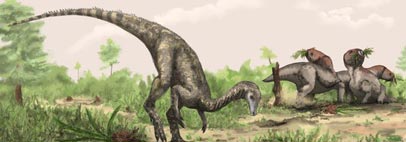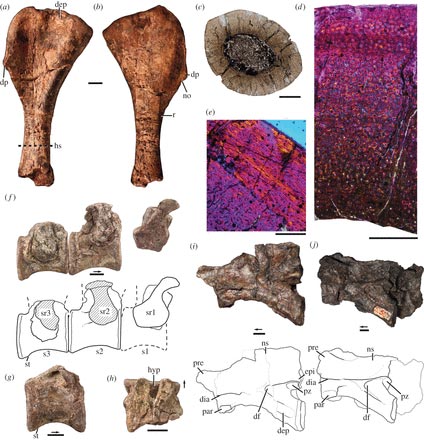Putting Back the Date of Dinosaur Evolution – The Oldest Dinosaur?
Nyasasaurus parringtoni – A Contender for the Earliest Dinosaur Known to Science
Very little fossil evidence has been found to suggest when the first dinosaurs evolved. Palaeontologists have unearthed a number of dinosaur specimens from the southern continents, most notably South America, these date from the Late Triassic (Carnian faunal stage). However, by the Late Triassic some 225 million years ago, there is evidence to suggest that the three great lineages of the Dinosauria – Theropoda, Sauropoda and the Ornithischia (bird-hipped dinosaurs) were already evolving. This suggests that the Dinosauria may have undergone rapid diversification during the Late Triassic, or these groups of dinosaurs may share a common ancestor that existed much earlier, the Dinosauria having evolved sometime in the Middle Triassic.
The fossil evidence for a much earlier evolution of the Dinosauria has yet to be unearthed, but a team of international scientists have reported on the analysis of some fragmentary bones that intriguingly, may suggest that the first dinosaurs evolved some 240 million years ago, much earlier than many palaeontologists previously thought.
The Earliest Dinosaur
Published in the scientific journal “Biology Letters”, a research team consisting of scientists from the Natural History Museum (London), the University of California and the University of Washington describe the fragmentary fossils of a small, bipedal reptile that show anatomical characteristics ascribed to the Dinosauria. These fossils could represent the oldest known dinosaur discovered to date, or it could be a fossil from another Archosauria clade, closely related to the true dinosaurs.
An Illustration of Nyasasaurus (Tanzania 240 million years ago)
Picture credit: M Witton/NHM
Lifua Member of the Manda Beds
The fossils were found in the layer of rocks known as the Lifua Member of the Manda Beds, Ruhuhu Basin, southern Tanzania by Francis Rex Parrington in the mid 1930s and donated to the Natural History Museum (London) about twenty years later. Using biostratigraphic analysis, (studying fossils of other animals found in the same layer of rock), this part of the Manda Beds formation of Tanzania has been dated to approximately 242 – 240 million years ago (Anisian faunal stage of the Middle Triassic). The material had laid in storage, but the Anglo/American research team analysed the fossils, which consist of an upper arm bone from the right arm (humerus), three partial pre sacral vertebrae (back bones from in front of the hip region) and three sacral vertebrae, fused back bones over the hip joints. These fossils do show anatomical and morphological traits that have been recognised in known dinosaur genera. This could suggest that the fossils represent a basal form of the dinosaurs, referred to as a dinosauriform.
Fossils Provide Evidence of a Dinosaur?
Picture credit: Biology Letters
The picture above shows the fossil bones and scientific drawings made. Also included are close ups of dyed section of slide material taken from the cross section analysis of the humerus. This revealed rapid bone growth associated with an active animal, similar histology has been recorded in dinosaur bone studies.
Nyasasaurus parringtoni
The animal has been named Nyasasaurus parringtoni, as the fossils were discovered close to Lake Nyasa (also known as Lake Malawi), whilst the species name honours F. R. Parrington who found the holotype material. Living amongst other types of reptiles such as the rhynchosaurs, cynodonts and dicynodonts N. parringtoni was probably around 2-3 metres long, with most of its length being made up of a long, thin tail. It was most probably bipedal and highly cursorial. It is not known whether this reptile was carnivorous.
Following the Permian mass extinction event that marked the end of the Palaeozoic, there were a number of different types of reptile that diversified to fill the niches left by the huge number of terrestrial genera that had became extinct. Scientists have speculated that the ancestors of the Dinosauria were just one such group, part of a larger grouping of reptiles known as the archosaurs. The anatomy of the ankle bones of dinosaurs are different from most other archosaurs, they have a straight-hinge joint between the ankle and the metatarsals of the foot. This is known as a “mesotarsal ankle”.
For models and replicas of Triassic archosaurs and other prehistoric animals: Prehistoric Animal Figures (CollectA Deluxe Scale Models).
It is this arrangement of bones that may have given the Dinosauria an advantage over other Triassic reptiles as it seems to provide a basis for faster locomotion on land. It could be suggested that the earliest true dinosaurs were fleet footed, agile runners and gradually, being slightly better adapted to move rapidly on land, these animals with their “specific ankle bone arrangement” diversified and evolved into a myriad of forms – giving rise to the Theropoda, the sauropods and the bird-hipped ornithischians.
The humerus (upper arm bone), has a flange of bone which served as an anchor point for strong pectoral (chest) muscles. This feature known as a deltopectoral crest; extends down the side of the bone for nearly a third of the humerus’s length. This is an anatomical characteristic seen in phylogenies related to the Dinosauria. The front tip of this crest is pushed out sideways a feature of the humerus bone seen only in certain dinosaurs such as the Late Triassic Heterodontosaurus.
Based on this evidence, N. parringtoni may represent the earliest known dinosaur discovered to date. However, the scientists responsible for this research stop short at declaring this material as definitively belonging to an early member of the Dinosauria. The fossil material is fragmentary and more fossils from the Nyasasaurus genera will need to be found before this specimen can be ascribed to a basal member of the dinosaurs.
The paucity of the vertebrate fossil record from the Middle Triassic prevents palaeontologists from building up a more complete picture of the evolutionary development of the Dinosauria. From the evidence discovered to date, it does seem that the dinosaurs evolved in the Southern Hemisphere but which of the various forms of archosaur are the direct ancestors of the Dinosauria is very difficult to assess. A closely related, sister taxon to the Dinosauria known as the Silesauridae share a number of anatomical characteristics with true dinosaurs and these animals may have had a common ancestor. Examples of Silesaurids have been found in the same region of Tanzania as the fossils of N. parringtoni, indeed, given the fragmentary nature of the holotype material; palaeontologists cannot rule out the possibility that N. parringtoni may be a member of the Silesauridae and not a basal member of the Dinosauria.
It is also possible that cursorial reptiles living in the same environment could have evolved characteristics that we now associate with the Dinosauria, independently. This would be an example of convergent evolution. Clearly, more fossil evidence is required before palaeontologists can confidently back date the Dinosauria to the Middle Triassic of southern Africa.
To read a blog article on silesaurid discoveries in Tanzania: Possible Evidence of the Earliest Dinosaurs.



